|
|
Dear colleagues
For the first time you read about Particle Physics in this Newsletter. Not because it would be new to PSI, it is there since the beginning in the 1970s, but because we continue to do more and more things together across community boundaries. We have joined DUO to manage our short term user visits and will soon include our proposal submissions.
Particle physics, as SINQ and SμS, relies on HIPA and its beamlines for world-leading experiments in fundamental precision physics with pions, muons and ultracold neutrons. ...
Read the full text of Klaus Kirch below !
|

Klaus Kirch
|
|
Next proposal submission deadlines:
|
|
|
Magnetic remanence in single atoms
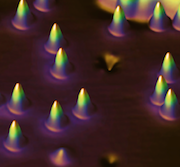 SLS - The smallest magnet SLS - The smallest magnet
Single holmium atoms adsorbed on few monolayers of magnesium oxide are extraordinarily stable magnets. They retain a significant fraction of their magnetization when the external magnetic field is switched off. This has been shown recently in a study combining x-ray magnetic circular dichroism performed at the Swiss Light Source (SLS) and at the European Synchrotron Radiation Facility (ESRF) as well as scanning tunneling microscopy. The results open perspectives of storing and processing information at ultrahigh density.
Read the full story
|
|
|
F. Donati et al, Science 352, 318 (2016)
|
|
|
Robust metastable skyrmions and their triangular–square lattice structural transition in a high-temperature chiral magnet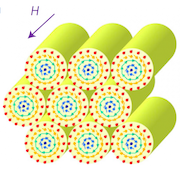
SINQ - latest news on Skyrmions
Skyrmions, topologically protected nanometric spin vortices, are being investigated extensively in various magnets. Among them, many structurally chiral cubic magnets host the triangular-lattice skyrmion crystal (SkX) as the thermo- dynamic equilibrium state. However, this state exists only in a narrow temperature and magnetic-field region just below the magnetic transition temperature Tc, while a helical or conical magnetic state prevails at lower temperatures. Here we describe that for a room-temperature skyrmion material, a field-cooling via the equilibrium SkX state can suppress the transition ...
Read the full abstract
|
|
|
K. Karube et al, Nature Materials 15, 1237 (2016)
|
|
|
Intrinsic Ferromagnetism in the Diluted Magnetic Semiconductor Co:TiO2
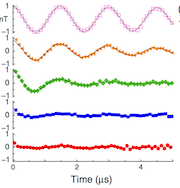 SμS - Tuning ferromagnetism with oxygen SμS - Tuning ferromagnetism with oxygen
Here we present a study of magnetism in Co0.05Ti0.95O2−δ anatase films grown by pulsed laser deposition under a variety of oxygen partial pressures and deposition rates. Energy-dispersive spectrometry and transmission electron microscopy analyses indicate that a high deposition rate leads to a homogeneous microstructure, while a very low rate or postannealing results in cobalt clustering. Depth resolved low-energy muon spin rotation experiments ...
Read the full abstract
|
|
|
H. Saadaoui et al, Physical Review Letters 117, 227202 (2016)
|
|
|
SwissFEL inauguration ceremony
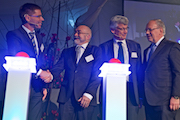 SwissFEL - Pressing the "red button" SwissFEL - Pressing the "red button"
On the 5th of December 2016, the Paul Scherrer Institute PSI held an inauguration ceremony for its new large-scale research facility SwissFEL, with Johann N. Schneider-Ammann, President of the Swiss Confederation, in attendance. Scientific breakthroughs the Swiss free-electron X-ray laser is expected to generate will drive important developments in the areas of energy and environment, information technology, and health.
Read more
|
|
The deuteron too poses a mystery
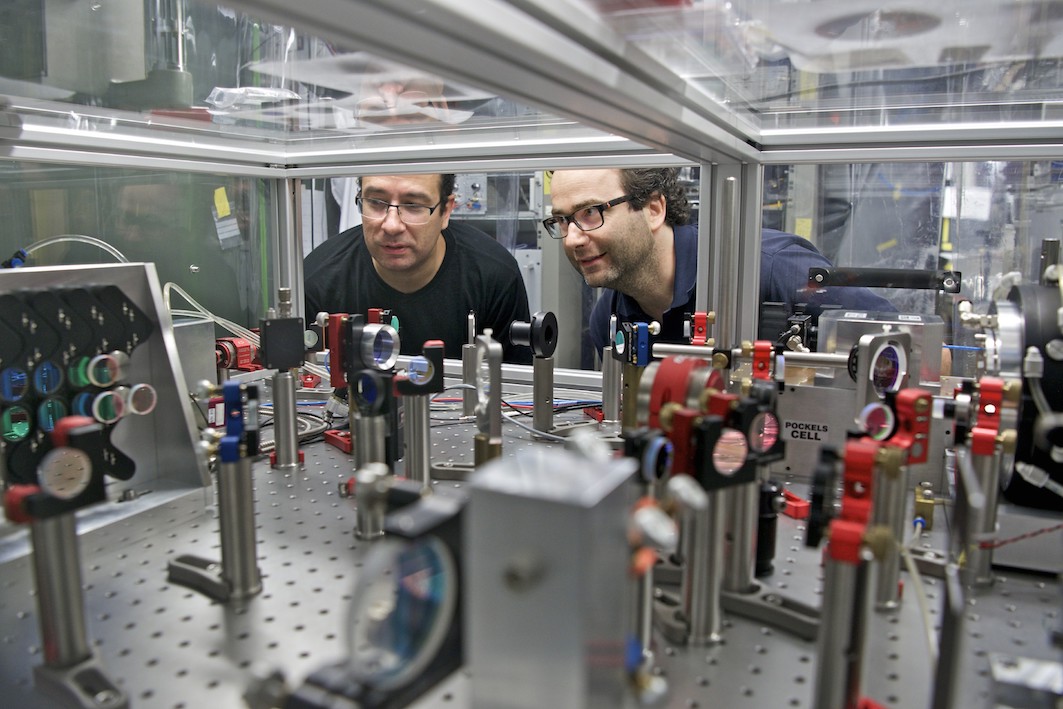 Particle Physics - The deuteron is smaller than previously thought Particle Physics - The deuteron is smaller than previously thought
The deuteron — one of the simplest atomic nuclei, consisting of just one proton and one neutron — is considerably smaller than previously thought. This finding was arrived at by an international research group that carried out experiments at the Paul Scherrer Institute, PSI. The new result is consistent with a 2010 study by the same group, in which the researchers measured the proton and found a significantly smaller value than previous research using different experimental methods. The result from 2010 formed the basis for what has been known since then as the proton radius puzzle. The new measurement ...
Read the full abstract
|
|
|
R. Pohl et al, Science 353, 669 (2016)
|
|
|
New neutron microscope - available for SINQ users now
SINQ
The new 'Neutron Microscope' is a high spatial resolution (5 micrometers) neutron imaging instrument at SINQ. It is designed as a self-contained instrument that can be transferred between different beamlines. From now on it is available for the user community at POLDI (thermal neutrons) and ICON (cold neutrons), more information.
For the beamtime application please choose 'Neutron Microscope' as instrument and later on select either POLDI or ICON as preferred instrument to perform the experiment. Contact: pavel.trtik@psi.ch
|
|
234 new proposals received
SμS
The Swiss Muon Source is highly demanded by its users. In 2016 the User Office counted totally 234 new beam time requests for SμS. That exceeds the average number of recent years by almost 15% and even the previous record from 2013. The General Purpose Spectrometer GPS received by far the most proposals (89) followed by LEM (39), DOLLY (30) and GPD (28).
The large number of proposals of course is also related to high overbooking factors: the average oversubscription for the SμS instruments in 2016 was 2.1, which means that many beamtime requests again had to be rejected. The next submission deadline will be in June 2017, the respective call for proposals will be announced in May.
|
|
First protein structure solved using the JUNGFRAU detector
SwissFEL and SLS
JUNGFRAU is a charge-integrating, two-dimensional pixel detector developed at the Paul Scherrer Institut for use at free-electron lasers, in particular SwissFEL, and synchrotron light sources. On the 10th October, the first protein crystallography experiment using the JUNGFRAU detector, was performed at the beamline X06SA (PXI) of the Swiss Light Source by the members of the Protein Crystallography and Detectors groups at PSI. Diffraction from single, native insulin crystal was recorded on two JUNGFRAU modules consisting of one million pixels in total. The data were of excellent quality, as judged by the overall crystallographic data statistics. It was possible to perform de novo structure determination from this data using single-wavelength anomalous diffraction phasing method. This result demonstrates that the quality of diffraction data recorded using the JUNGFRAU detector is sufficient for obtaining accurate measurements of Bragg peak intensities, which were necessary for successful structure solution. Read more.
|
|
PSI2016 brought together fundamental precision physics community at PSI
Particle Physics
The Laboratory for Particle Physics (LTP) at PSI organized the PSI2016 workshop on 'Physics of fundamental Symmetries and Interactions'. The series of workshops started in 2007 and was continued with the PSI2010 and PSI2013 meetings. More than 170 participants from all over the world attended the all-plenary meeting at PSI with presentations of news and results by leading scientists and young researchers. Precision low-energy tests of the Standard Model of Particle Physics and searches for physics beyond it with a range of probes from neutrons, muons, antiprotons, kaons, and neutrinos to atoms and molecules formed the common theme of the discussions.
About everybody in this vibrant community is looking forward to PSI2019!
|
|
Rent a desk: New workplaces for our users close to the Guest House
User Office
Since October we can now offer new and comfortable office space for our short and long term users in the new building WBWB next to the PSI Guest House. The open-plan office is presently equipped with 12 desks, 32 lockable cabinets, a printer/photocopy machine and both LAN and WiFi access.
The work places can be „rented“ against a small deposit (similar to the system we use to let the bicycles). The use of the desks and cabinets is coordinated by the PSI User Office. Please contact us for further information.
|
|
Editorial
Dear colleagues

For the first time you read about Particle Physics in this Newsletter. Not because it would be new to PSI, it is there since the beginning in the 1970s, but because we continue to do more and more things together across community boundaries. We have joined DUO to manage our short term user visits and will soon include our proposal submissions.
Particle physics, as SINQ and SμS, relies on PSI's High Intensity Proton Accelerator "HIPA" and its beamlines for world-leading experiments in fundamental precision physics with pions, muons and ultracold neutrons. The projects often take many years and are mostly carried out in international collaborations. 350 individual users spend a total of about 10’000 days per year working on their particle physics experiments, including users of the proton irradiation facility of our lab.
If you are using x-rays, neutron scattering or μSR you have very likely at some point used hard- or software initially developed for particle physics. Our experiments often need custom developments, and we make them available whenever possible. Likewise, for our own experiments, we benefit substantially from the other facilities and perhaps from your particular know-how to develop solutions.
Communication across field boundaries always helps.
Klaus Kirch,
Head - Laboratory for Particle Physics LTP, NUM department, PSI
|
|
JUSAP - The Joint Users Association
The Joint Users Association at PSI (JUSAP) is the panel to represent users and to make the PSI management aware of their feedback and concerns. The panel members for the period 2017-2020 have now been elected. The panel has been extended to also represent the users of the particle physics facilities as well as the future SwissFEL users.
|

Sarah Dunsiger
|
|
Totally 258 users participated in the electronic election. The eight elected members are (in brackets the number of votes):
- Dirk Wiedner (139) – Particle physics facilties
- Joanna Hoszowska (164) – SwissFEL
- Sarah Dunsiger (158) – SμS
- Karl Krämer (130), Niels B. Christensen (146) – SINQ
- Mathilde Léna Reinle-Schmitt (160) – SLS and industrial users
- Claude Monney (173), Annick Froideval (134) - SLS
The new panel would like to thank the leaving committee members for their commitment, as well as the user community for their participation in the election process. The user community is invited to contact the PSI user office or the committee members directly with their comments and suggestions, as part of the continuous effort to improve the facility, more information.
With best wishes for 2017 from the entire JUSAP committee,
Sarah Dunsiger (JUSAP committee chair)
|
|
Electronic Materials and Applications 2017
January 18-20, 2017, Orlando, FL, USA
LiXS 2017: Liquid-Xray-Spectroscopy
January 17-18, 2017, Gif-sur-Yvette, France
12th Soleil Users' Meeting
January 19-20, 2017, Gif-sur-Yvette, France
Joint DESY Photon Science and European XFEL Users' Meeting: Research with Synchrotron Radiation and FELs
January 26-27, 2017, DESY Hamburg, Germany
PSI Particle Physics: BVR 48 - Benutzerversammlung Ring
February 6-8, 2017, Villigen, Switzerland
ESRF User Meeting 2017
February 6-8, 2017, Grenoble, France
12th ESS IKON Meeting
February 14-16, 2017, PSI Villigen, Switzerland
HERCULES European School 2017: Neutrons and synchrotron radiation for science
February 27 - March 30, 2017, Grenoble, France
ISIS Neutron Training Course
February 28 - March 9, 2017, Didcot, UK
37th Berlin School on Neutron Scattering
March 2-10, 2017, Berlin, Germany
1st Photon School at HZB
March 14-24, 2017, Berlin, Germany
9th MaMaSELF Status Meeting
May 16-19, 2017, Rigi Kulm, Switzerland
more events
|
|
|
|